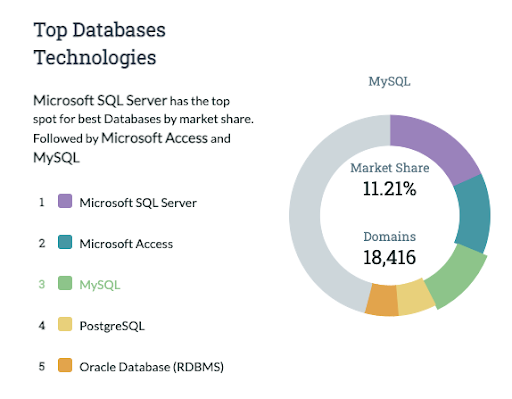
One of the most regular app development services in the IT field is the MySQL development. Let’s review the market shares distribution between most popular DBMS:
Database Market Share Mid-2021
Below pie chart show the database marketshare in Mid-2021: (source: datanyze .com)
Quite illustrative, isn’t it? It is rather understandable, with the big names amongst MySQL users including Paypal, Cisco, LinkedIn, Adobe, Amazon, Verizon, Google, Dropbox, Facebook, Booking.com, Twitter, Youtube and Flikr, and app platforms add Joomla, Drupal, WordPress, phpBB and many others, no wonder MySQL is so popular.
Some History
MySQL, along with its straightforward logical approach, simplicity and usability, spiced with rigid reliability alike Volvos and SAABs, was born in Uppsala, Sweden. MySQL AB, responsible for its creation and development, was formed by Michael “Monty” Widenius, David Axmark and Allan Larsson. Initially developed for personal use, loosely based on proprietary mSQL, MySQL had seen its first release in 1995.
In 2008 the company was acquired by Sun Microsystems for a billion USD as one of the last Sun’s acquisitions before it had been purchased by Oracle Corporation in 2010. Monty Widenius had started a campaign against Oracle’s acquisition of MySQL, but it eventually failed, the merge was complete and Oracle promised to further develop and enhance MySQL.
What Does It Offer?
- Top MySQL features count:
- Wide cross-platform support
- Unicode and SSL support
- Native storage engines InnoDB, MyISAM.
- ACID compliance when using InnoDB and NDB Cluster Storage Engines
- Triggers, Cursors and Updatable views
- Query caching and full-text indexing and searching
- And many others
Minor updates are released every two month, the sources are available on both the native MySQL site and their GitHub repository.
Mind you, when we say cross-platform in reference to MySQL we really mean:
AIX, BSDi, FreeBSD, HP-UX, eComStation, i5/OS, IRIX, Linux, macOS, Microsoft Windows, NetBSD, Novell NetWare, OpenBSD, OpenSolaris, OS/2 Warp, QNX, Oracle Solaris, Symbian, SunOS, OpenVMS, SCO OpenServer, SCO UnixWare, Sanos and Tru64.
Quite a bunch, isn’t it?
Scale
MySQL had started as a small task project, but eventually it evolved. Largely. Modern days MySQL is capable of fulfilling tasks of small to medium scale not breaking a sweat, but it also has serious capabilities of managing much bigger assignments.
GUI
MySQL is famous for its ease of use, yet surely an interface is needed. The open nature of MySQL had spawned quite a number of third party front-ends in addition to their own official one. So not full list of MySQL GUIs reads:
- MySQL Workbench – the official integrated environment for MySQL. Developed by MySQL AB, it allows users to administer MySQL databases and design database structures using visual graphical tools. The package is available in both GPL Community Edition and in a more advanced proprietary Standard Edition.
- Adminer (formerly known as phpMinAdmin) is a free MySQL front end by Jakub Vrána for managing content in MySQL (PostgreSQL and couple other) databases. It is distributed under the Apache license (or GPL v2), and is represented as a single PHP file.
- Database Workbench by Upscene Productions. Databases Workbench supports multiple database systems, includes cross database tools and thus provides single GUI for multiple project if needed.
- DBEdit – a cross-platform database editor supporting Oracle, DB2, MySQL and any JDBC driver providing DB.DBEdit is free, open source and is hosted on SourceForge under GNU licence.
- LibreOffice Base and OpenOffice.org Base both provide MySQL support.
- Many other…
Easy To Learn MySQL
Easy To Find Help On MySQL
Easy To Hire MySQL Freelancers
Bottom line
A few years passed after Oracle’s acquisition of MySQL and as we can see they did keep their promise. Oracle is known for their superb modernistic and flexible support service, and now it has special bundles of support plans for MySQL too.
Max Hornostaiev, CTO of Erminesoft, an app development company. Having more than 10 years of experience in IT field, he is sure the key for growth is constant self-development, learning new things and knowledge sharing.
Article Updates
- Article Updated on September 2021. Some HTTP links are updated to HTTPS. Updated broken links with latest URLs. Some minor text updates done. Content validated and updated for relevance in 2021.

